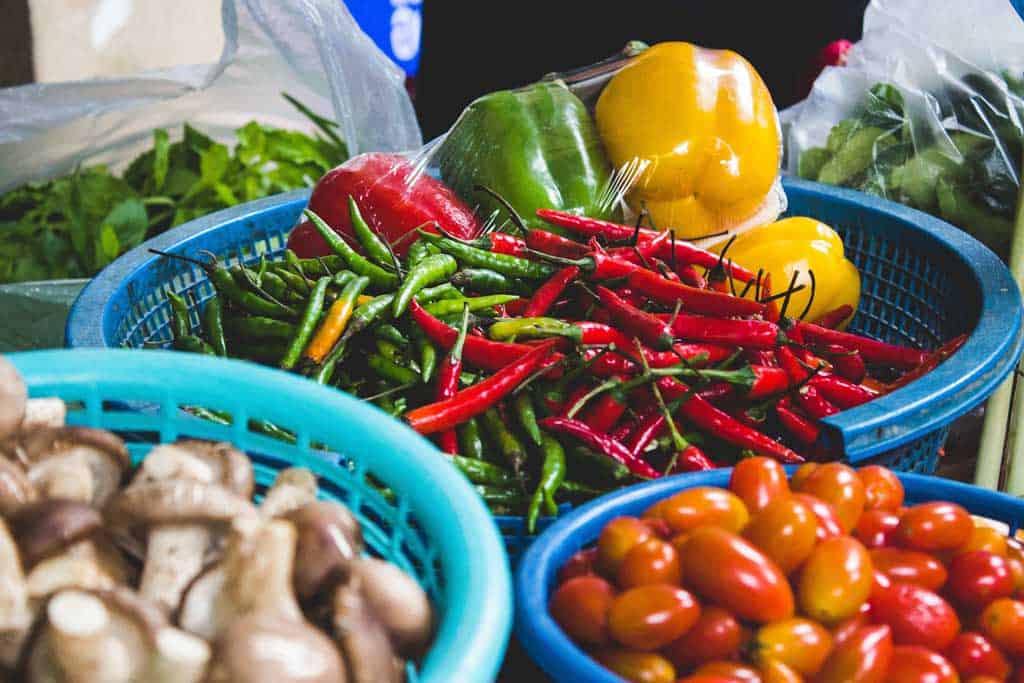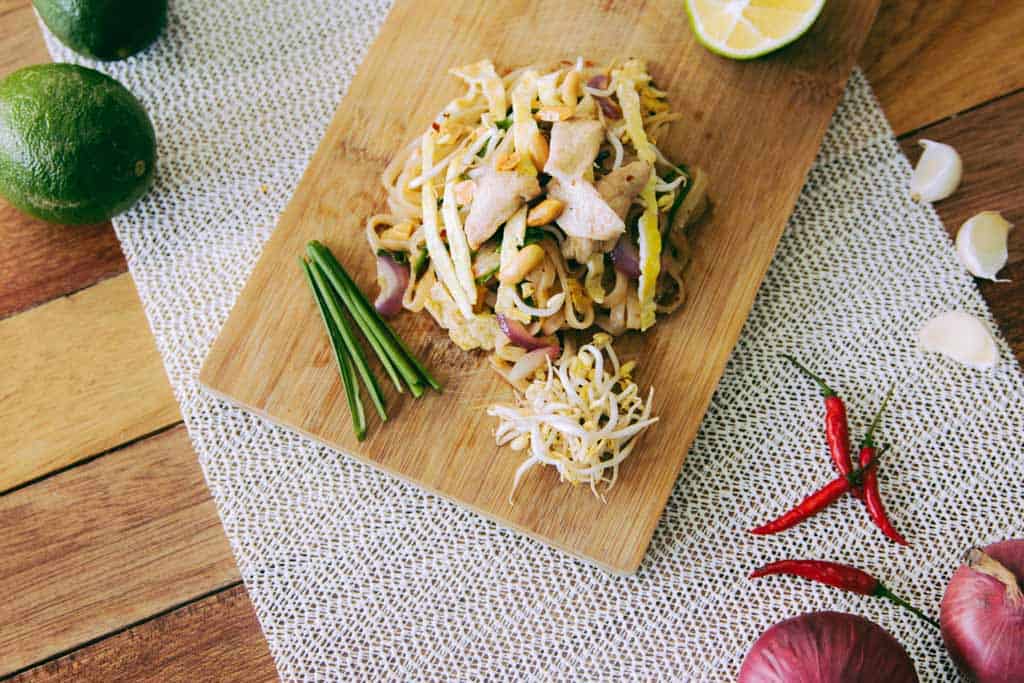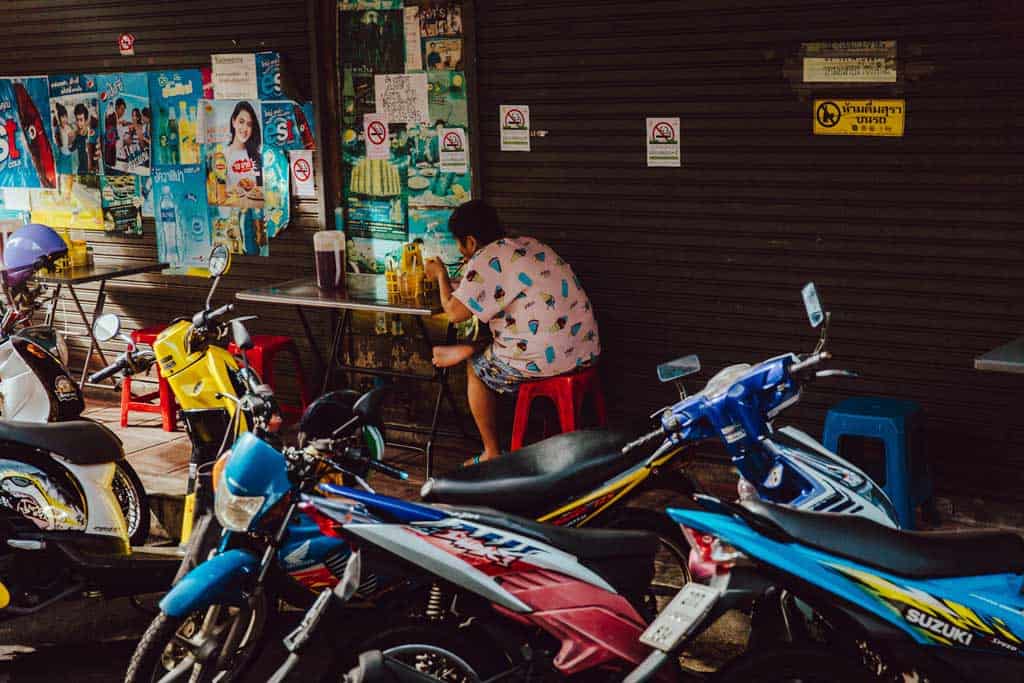A comprehensive guide to the best food in Thailand.
Thailand is home to one of the most famous cuisines on the planet.
Thai restaurants and Thai dishes are abundant all over the world. But there is nothing quite as special as tasting the traditional food right at the source.
In Thailand’s food culture, the recipes are simple, the ingredients are fresh, and the food is always prepared and served with a smile.
Foodies flock from all over the globe to take a Thai cooking class where they can grind their own curry paste and sprinkle peanuts over their own, homemade Pad Thai.
Travel documentaries often show tourists trying fried scorpions and grasshoppers in the street or sipping fresh coconuts on the beach.
The quality and uniqueness of Thai food is no secret, and the food only adds to Thailand’s list of appealing qualities.
Thailand is very diverse and very cheap, which means there is so much different Thai food to try and it is all affordable.
This article will serve as a guide to the best food in Thailand.
If you’re travelling to Thailand for the first time and asking yourself questions like “What are the best dishes to try? How much does it cost? And what’s the deal with street food?” then this is the article for you.
You’ll also learn about Thai food culture and see some recommendations for amazing places to eat around the country.
READ MORE: Plan your trip to Thailand with our Thailand Travel Guide.
Table of Contents
Thailand Food Culture
No one loves the delicious and flavourful Thai cuisine more than the Thai people themselves.
Thai food is celebrated by the locals, and any significant events are always supplemented with food.
Because food is so central to Thai culture, there are some specific customs, traditions, and eating habits associated with Thai food that travellers should be aware of.
Thai Eating Habits
In Thailand, most meals are eaten family-style. This means a group of family or friends sit around a communal table, order lots of different dishes that everyone can share.
Shoes are usually removed before entering a restaurant or home, and locals often sit on the floor around a low table.
There are plenty of restaurants in Thailand that have normal tables and chairs, but if you are ever invited to a local’s home for dinner you can expect to probably sit on the floor.
Meals are eaten with a fork and a spoon. You usually don’t get a knife, and you use your fork to push rice onto the spoon before taking a bite.

The Importance of Presentation
Thais take food presentation very seriously.
Dishes are prepared in an attractive way, and at restaurants and special events, you’ll usually be able to spot some fruit and vegetable carvings.
Carving fruits and vegetables is a highly-respected art form in Thailand, and the designs people can create in a simple melon, cucumber, or carrot are astonishing.
Traditional Thai Flavours and Ingredients
Thai food has plenty of consistent local ingredients that you can find in almost any dish.
Garlic, black pepper, galangal (local ginger), lemongrass, Thai basil, chilli, Kaffir lime, coconut milk, fish sauce, palm sugar, and peanuts are all some of the most common ingredients in Thai food.
At communal meals, locals try to have sweet, salty, sour, and spicy flavours on the table.
If you are very sensitive to spice, beware of the frequent use of chilli in Thai food.
When eating out in a restaurant, make it clear that you want “no spice” in your meal (“mai phet” in Thai).
Regional Differences in Thai Cuisine
Thai food varies in different parts of the country, so it is helpful to brush up on your knowledge of the country’s geography and how the food changes.
Food in Northern Thailand is the least spicy. The flavours tend to be a bit mild, and dried spices are more common than fresh, intense spices.
Thai food in Central Thailand is the sweetest. Here you’ll find lots of dishes sweetened with coconut milk and palm sugar.
Food in Southern Thailand is the spiciest, and many dishes revolve around seafood.
Despite these regional differences, you can still find all variations of sweet and spicy around the country. Fish sauce is used everywhere, as are the usual spices.
There are also plenty of international communities in Thailand that infuse their own culture into the cuisine.
Chinese, Indian, Malay, and Muslim influences are common throughout the country.
Check out this great cooking class in Phuket if your travels will take you down to the south!
Vegan/Vegetarian Diets in Thailand
Being a vegetarian in Thailand is very easy.
Lots of the cuisine revolves around rice, noodles, and fresh fruits and vegetables.
Tofu is also very common, and there are often menu options for tofu instead of meat in certain dishes.
Being a vegan is a bit more difficult, but it is definitely possible.
Fish sauce and oyster sauce are used in lots of dishes, and egg is often thrown into pad Thai.
Brush up on your Thai language skills so you can ask for dishes without animal products, or just stick to the touristy areas where English is common.
But in general, tofu curries and veggie stir-fries are very easy menu options for vegetarians or vegans.

Best Traditional Thai Dishes to Try
Now that you understand the basics of Thai cuisine, it is time to dive into the actual dishes. From the delicious mango sticky rice to the hearty panang curry to the spicy tom yum goong soup, there is so much to try.
You should try as many of these as possible throughout your stay in Thailand!
Soup and Salad
Soups and salads in Thailand are usually small dishes eaten as an appetizer or a light snack.
They are very light and refreshing, though often spicy so keep that in mind if you have a sensitive palate! Lime juice and chilis are often combined for a zesty taste.
Tom Yum Goong: A spicy and sour soup made with fresh lime juice, lemongrass, mushrooms, and shrimp (Tom Yum Goong is the most popular Thai soup!)
Tom Kha Gai Soup: Tom Kha Gai is a rich and creamy soup made with coconut milk and chicken
Som Tam: A spicy green papaya salad made of shredded green papaya, tomatoes, string beans, carrots, peanuts, and a light, sweet and spicy sauce and lime juice
Yam Talay: A spicy but light salad that mixes seafood with tomatoes and thin rice noodles and lime juice
Yum Pla Duk Foo: A salad composed of crispy fried catfish and chilled green mango strips
Combine traditional Thai dinner with a spectacular view in Bangkok!
Noodles and Stir Fry
There are lots of amazing noodle dishes and fried rice dishes in Thailand. Fish sauce, soy sauce, and oyster sauce, as well as garlic and chili, are almost always used in stir fries.
Rice noodles, egg noodles, and wheat noodles are all common in Thai food. Pad Thai is the most famous option but there are some other less popular Thai food dishes you must try!
Pad Thai: Pad Thai is one of the most famous Thai dishes! Pad Thai is a fried noodle dish that includes bean sprouts, peanuts, spring onions, fish sauce, scrambled egg, and tofu, shrimp, or chicken
Pad See Eiw: A noodle dish with wide, flat noodles and usually beef, chicken or pork with soy sauce
Khao Pad: Khao pad is a classic Thai fried rice. Khao pad is often served with scrambled egg or a fried egg, a few veggies and your choice of meat or tofu
Khao Med Ma Muang: A delicious stir fry with cashew nuts, veggies, soy sauce, and chicken, though you can also get vegetarian cashew nut stir fry as well
Pad Krapow Moo Saap: Stir-fried minced pork or chicken mixed with garlic, chili, and Thai basil served over rice

Curries
Thai curry is one of the most flavourful dishes you can get in Thailand.
Locals grind their own curry paste using a mortar and pestle, so the ingredients are fresh and fragrant. Most curries use coconut milk, such as red and green curry and massaman curry. The coconut milk makes them thick and creamy, but not overly intense.
All Thai curries are served with a side of rice, and you can usually choose if you want tofu, chicken, shrimp, pork, or beef as your main protein.
Green Curry: Green curry is the spiciest Thai curry, made with lots of fresh green chilli and usually made with Thai eggplant and coconut milk
Red Curry: Made with red chilli instead of green, red curry is often quite spicy as well and is often topped with Kaffir lime leaves and Thai basil
Massaman Curry: A hearty curry composed of mainly meat and potatoes, with an aromatic sauce including cinnamon, tamarind, and peanuts
Panang Curry: Panang Curry is the sweetest and least spicy of the curries, very creamy and delicious with lots of coconut milk
Khao Soi: Khao Soi is of the most popular Thai dishes in Northern Thailand. Khao Soi is a soup-style curry with crispy egg noodles
READ MORE: Try the best Thai food around the country in these top places to visit in Thailand!
Desserts
Thai food also has some amazing desserts! Though the savory dishes like Pad Thai, Khao Pad, Panang Curry, and Tom Kha Gai soup are the most iconic dishes, indulge in some delicious sweet treats in Southeast Asia as well.
Kao Niew Ma Muang: Also known as “Mango Sticky Rice”, this simple dessert is just a plate of sweet, thick rice with coconut cream and a side of fresh mango. Mango sticky rice is seriously delicious!
Khao Nom Krok: These are tiny pan-fried coconut pancakes that are crispy on the outside and soft and chewy on the inside

Best Street Food in Thailand
Some of the best Thai food is found in the street.
Street food is a huge part of Thai culture. Street markets pop up all over the country where travellers and locals alike can indulge in fresh and cheap local treats.
Some of the traditional Thai dishes listed above are also popular at street markets, like pad thai, papaya salad, mango sticky rice, and fried rice.
But some Thai specialties are more commonly found in the street and aren’t always available in sit-down restaurants.
Here are some quick descriptions of the best street Thai food.
Poh Pia Tod: Fried spring rolls served with sweet chilli sauce
Pa Pia Sod: A lighter alternative to the fried spring rolls, these ones are steamed instead
Cha Yen: Known as Thai iced tea, this sweet drink is made with a mix of black tea, red tea, and sweetened condensed milk, and is served over ice
Kai Jeow: A small omelette served over rice
Itim Kati: Delicious dairy-free ice cream made with coconut milk, usually served in an actual coconut with some of the coconut meat scraped into the ice cream
Satay Skewers: Strips of meat marinated in a flavourful sauce and grilled on a skewer
Kluay Tod: Deep-fried bananas often rolled in coconut flakes and sesame seeds
Fried Critters: Some street markets in Thailand will have fried scorpions, grasshoppers and other creepy critters for the risk-taking tourists to try
Fresh Fruit: Try some of the tropical local fruits, including dragonfruit, guava, mango, papaya, durian, mangosteens, rambutans, lychee and jackfruit
Fruit shakes: Some street vendors have lots of plastic cups filled with different assortments of fruit, where you can pick which cup you want and they’ll blend it with water and ice to make a healthy fruit smoothie

The Cost of Food in Thailand
Generally speaking, Thailand is a very affordable country. You can find delicious, high-quality Thai food for decent prices, regardless of whether you are eating on the street or in a sit-down restaurant.
Here is a brief overview of the cost of food in Thailand.
Street Food
Similar to most countries around the world, the cheapest place to eat in Thailand is in the street.
Because there is no real customer service or people waiting on you, you are solely paying for the cost of the Thai food and nothing else.
This means you can get amazing local food for dirt-cheap.
At a street market in Thailand, it is very common to find full meals for around 50 or 60 Baht, which is the equivalent of about 2 USD.
Little snacks cost even less. Fruit shakes usually cost 30 Baht (1 USD) and a single spring roll or meat skewer usually costs 10-20 Baht (0.30-0.60 USD).
So if you are travelling on a tight budget, eat most of your Thai food at a street market and you’ll save heaps of money.
BOOK NOW: Join a cooking class in Chiang Mai
Local Restaurants
Even if you want to sit down and have a meal, local restaurants can sometimes be just as cheap as street food.
Local restaurants refer to the typical hole-in-the-wall, family-run places where there are very few tourists and usually only a handful of menu items.
However, those few menu items are super traditional and not geared towards tourists, and they are usually cooked to perfection.
The average price for a Thai food meal in a small, local restaurant can cost anywhere from 60 to 150 Baht (2-5 USD).
Touristy Restaurants
Because Thailand hosts lots of tourists throughout the year, there are plenty of Western-style restaurants selling all the universal dishes.
You can find Italian restaurants, American burger bars, Irish pubs, Japanese sushi joints, Indian restaurants, Greek Restaurants, and plenty of health food cafes.
As these places are geared towards tourists, the prices are on the more expensive side compared to local prices.
But of course, you can also find authentic Thai food restaurants, they just might tone down the spices and up the prices for the tourists.
A Thai food meal in a tourist restaurant can cost anywhere between 100 and 300 Baht (Between 4 and 10 USD).
READ MORE: Plan the perfect trip to Thailand with these 1, 2 and 3-week itineraries.
High-End Restaurants
There are plenty of fancy restaurants in Thailand that are still affordable.
High-quality meals can cost a few hundred Baht, and they will probably taste just as delicious as the super cheap, local restaurants.
But for those who really want a taste of luxury, Thailand has lots of fine-dining restaurants as well.
As you are paying for the highest quality possible, Thai food meals at luxury restaurants can cost up to 1,000 Baht.
This is still only about 30 USD, which is incredibly cheap as far as fine dining goes.
So if you’ve always wanted to dabble in some creative and high-quality cuisine, Thailand is an affordable place to do it.

Best Places to Eat in Thailand
Now that you’ve learned all about the best food in Thailand and how much it costs, here is exactly where to find it.
From mango sticky rice and Thai fried rice, to noodles with fish sauce and garlic and green curry thick with coconut milk, you can find all the best Thai specialities in almost every restaurant.
There are so many incredible restaurants in Thailand that it would be impossible to cover them all, and of course, this list would vary based on personal opinion.
But if you are looking for a little inspiration about where to eat Thai food in various destinations around Thailand, here are some great ideas.
For each major city, you will find an option for street food, and options for budget, mid-range, and high-end restaurants.
BOOK NOW: Learn to cook traditional Thai in Koh Samui
Bangkok
When you travel to Bangkok, among the many great things to do will be to check out these places to eat.
- Street Food: Khao San Road Night Markets
- Budget: Ran Nai Oo
- Mid-Range: Krua Apsorn
- High End: Eat Me Restaurant
Chiang Mai
Visiting Chiang Mai is a must. So too is trying these delicious markets and restaurants.
- Street Food: Chang Phuak Gate Night Market
- Budget: Khao Soi Khun Yai
- Mid-Range: Reform Kafé
- High End: Oxygen Dining Room
Phuket
When you visit Phuket you’re going to want to give these places a try.
- Street Food: Bangla Road Street Food
- Budget: Mor Mu Dong
- Mid-Range: Nam Yoi Restaurant
- High End: Blue Elephant Governor’s Mansion
Krabi
Krabi has some pretty amazing dining options. Be sure to swing by these places when you visit Krabi.
- Street Food: Krabi Night Market in Chaofah Park
- Budget: Red Chilli Thai Cuisine
- Mid-Range: Kodam Kitchen
- High End: Gecko Cabane Restaurant
Koh Samui
When you make it to Koh Samui, checking out these markets and restaurants should be on the top of your list of things to do.
- Street Food: Chaweng Night Market
- Budget: The Hut Cafe
- Mid-Range: Kawin’s Kitchen
- High End: Supattra Thai Dining
READ MORE: Make the most of your trip to Thailand with these Thailand travel tips.
DISCLAIMER: Some of the links in this article are affiliate links, which means if you book accommodation, tours or buy a product, we will receive a small commission at no extra cost to you. These commissions help us keep creating more free travel content to help people plan their holidays and adventures. We only recommend the best accommodations, tours and products that ourselves or our fantastic editorial team have personally experienced, and regularly review these. Thanks for your support, kind friend!

